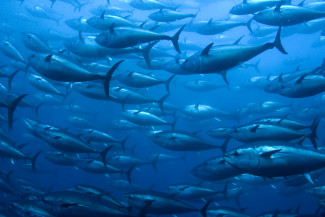
Johns Hopkins UniversityEst. 1876
America’s First Research University
Tunas and Billfishes of the World

I co-authored Tunas and Billfishes of the World with John Graves as the culmination of my 60 years of research on tunas, which began with studying tunas caught on a long-line cruise aboard the Bureau of Commercial Fisheries (now NOAA) vessel “Delaware” in the summer of 1957.
After completion of my Ph.D. at Cornell University—studying small freshwater fishes known as darters—I was hired by NOAA's Systematics Laboratory, based in the National Museum of Natural History in Washington, D.C. I was asked to straighten out the taxonomic relationships of tunas and to do it well enough that “the damned names won’t keep changing.”
After seven years of dissecting and measuring, Bob Gibbs and I concluded that there were seven species of tunas in one genus. I proceeded to study the rest of the family Scombridae: the bonitos (1975), Spanish mackerels (1984), double-lined mackerels (1992), frigate tunas (1996), and mackerels (1998), with several other papers on their relationships from 1979 to 1999. I co-authored a widely used catalog of the species for FAO in 1983.

In 2008, I was asked to chair the Tuna and Billfish Specialist Group of the IUCN (International Union for the Conservation of Nature) to assess the threat of extinction to all sixty-one species of tunas, mackerels, and billfishes. We published the results of several workshops in Science in 2011, concluding that seven species met the threshold for a threatened category.
Knowing that it would be time to re-evaluate the tunas and billfishes in 2021, I thought it would be timely to summarize all the published research on tunas and billfishes as a foundation for this re-evaluation and as a guide to their identification and biology, many species of which are highly important to commercial and recreational fisherfolk.
The over 2,000 references in sixteen different languages wouldn’t fit easily in the book so they are hosted online at Johns Hopkins University Press’s website. Our book replaces the widely-used-but-out-of-date FAO catalogs of the Scombridae and billfishes.
John Graves joined me as co-author to help with the billfishes and fisheries, as well as the biology of all the species. Celebrated wildlife illustrator Val Kells agreed to use her expertise to illustrate all the species in color and design the book.
The result is Tunas and Billfishes of the World, a lavishly illustrated, definitive guide that can also serve as the baseline for re-evaluating the threat status of all the species of this important group of fishes.
Bruce Collette is a research associate with the Smithsonian National Museum of Natural History and the chair of the Tuna and Billfish Specialist Group of the International Union for the Conservation of Nature. He is the co-author of several books, including Fishes: The Animal Answer Guide. Collette and John Graves are the authors of Tunas and Billfishes of the World, which features illustrations by Val Kells.


